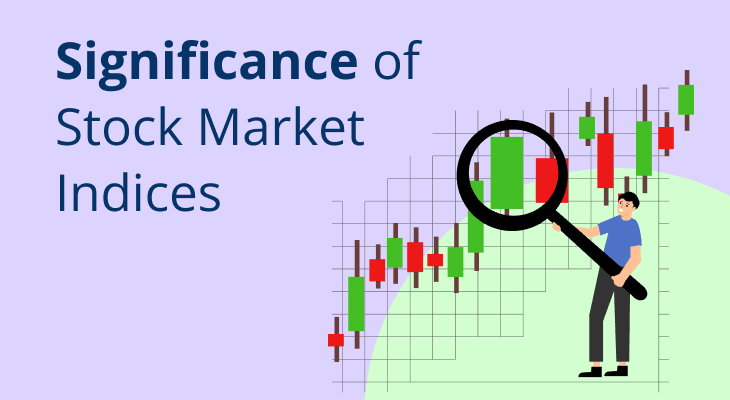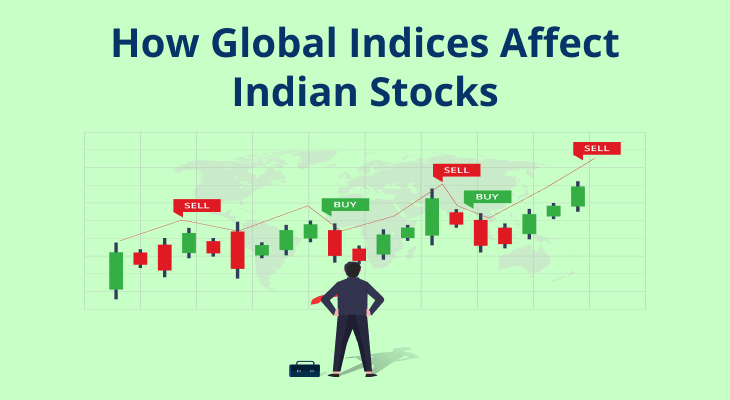
Table of content
- Introduction To Stock Market Indices
- Why Not Track Stocks Individually?
- How Indices Are Constructed & Calculated
- Types Of Stock Market Indices
- What Indices Indicate: The Significance
- Practical Uses For Investors
- How Indices Are Updated & Rebalanced
- Benefits Of Investing In Stock Market Indices
- Limitations & Risks
What Is The Significance Of Stock Market Indices?
When you hear that the Sensex rose by 300 points or that the Nifty 50 fell by 1%, what you are actually hearing is news about stock market indices. These indices are widely followed not just by professional investors but also by everyday market participants, regulators, policymakers, and even the media.
A stock market index is a statistical measure that represents the performance of a specific set of stocks. Since the Indian market alone has thousands of listed companies, it is impractical for investors to track each stock individually. That’s where indices step in. They simplify the process by grouping select companies and giving you a quick snapshot of market trends.
In this guide, we’ll break down what stock market indices are, how they are constructed, the different types of indices, their importance, and how you as an investor can use them wisely.
Introduction To Stock Market Indices
A stock market index is essentially a curated basket of shares that represent a portion of the stock market. Each index is designed to reflect a particular market segment, for example:
- Nifty 50 tracks 50 of the largest and most actively traded companies in India.
- BSE Sensex includes 30 blue-chip companies listed on the Bombay Stock Exchange.
Instead of analysing every listed company, indices provide an aggregate performance measure. Think of them as a “thermometer” of the market. A quick glance at Nifty or Sensex tells you whether the market sentiment (and the overall economic trend) is bullish, bearish, or flat.
Why Not Track Stocks Individually?
- The NSE alone has over 2,500 actively traded companies. Monitoring each is not feasible.
- Indices filter and represent only the most liquid, impactful stocks, giving investors a clearer, reliable picture of market direction.
How Indices Are Constructed & Calculated
The construction of indices follows strict rules to ensure they accurately represent the chosen market segment.
- Selection of Constituents: Each index has eligibility criteria. For example, companies in the Nifty 50 must meet benchmarks in terms of market capitalisation, trading volume, and liquidity.
- Weighting Methodology:
- Free-float market capitalisation: Most Indian indices, like Nifty 50, assign weights based on the free-float market cap of each company (market cap adjusted for shares available to public investors).
- Equal weight indices: Here, every stock gets the same weight, regardless of size.
- Other methods: Price-weighted (like Dow Jones) or factor-weighted (used in smart beta indices).
- Calculation Formula: The index level is calculated using the weighted values of its constituents, divided by a base value. The base year and base index value provide a reference point.
This systematic calculation ensures indices remain objective and transparent benchmarks.
Types Of Stock Market Indices
Stock market indices come in different forms depending on the market segment they represent.
1. Broad-based Indices
- Represent the overall market.
- Examples: Nifty 50, Sensex, Nifty 500.
- Best used for gauging general market sentiment.
2. Sectoral / Thematic Indices
- Track specific industries or themes.
- Examples: Nifty IT, Nifty Pharma, Nifty Bank.
- Useful for investors who want exposure to a particular sector.
3. Market-Cap Based Indices
- Group companies by size:
- Nifty Smallcap 250
- Nifty Midcap 100
- Nifty Largecap 100
- Help compare how different market segments (small, mid, large) are performing.
4. Strategy / Hybrid / Fixed-Income Indices
- Designed using custom rules or strategies, such as:
- Nifty Low Volatility 30 (stable stocks)
- Nifty Quality 30 (high-quality earnings)
- Fixed-income indices track bond markets.
- These indices bridge passive investing with strategy-driven approaches.
What Indices Indicate: The Significance
Stock market indices serve as barometers of the economy and market health. Their significance includes:
- Market Sentiment: Rising indices suggest optimism and growth; falling indices indicate bearishness or caution.
- Economic Trends: Indices often reflect broader macroeconomic conditions like GDP growth, inflation, or global events.
- Performance Benchmark: Mutual funds and portfolio managers compare their performance against indices.
- Investment Decisions: Investors use indices to decide asset allocation, evaluate sectors, and set strategies.
- Global Linkages: Indian indices move in sync with global peers like the S&P 500 or the FTSE, indicating integration of world markets.
Practical Uses For Investors
For investors, stock market indices are not just theoretical concepts — they have everyday practical use cases:
- Benchmarking performance: Compare your portfolio returns against benchmarks like Nifty 50 or Sensex.
- Passive investing: Invest in index funds or ETFs that replicate indices.
- Sector rotation: Track sectoral indices to identify outperforming industries.
- Market timing: Use indices to gauge entry or exit points, though not always foolproof.
- Risk assessment: Indices highlight volatility trends that can help manage risk.
How Indices Are Updated & Rebalanced
Indices are not static; they are reviewed periodically to ensure relevance.
- Review frequency: Major Indian indices are rebalanced semi-annually (twice a year).
- Entry and exit of stocks: Companies may be added or removed based on criteria like market cap, liquidity, and financial stability.
- Weight adjustments: Changes in shareholding, mergers, or stock splits affect company weights.
For example, if a company’s market cap falls drastically, it might get excluded from the Nifty 50, making way for a stronger player.
Benefits Of Investing In Stock Market Indices
For many investors, stock market indices are not just market barometers, they are also investment opportunities. By investing in indices through index funds or ETFs, you gain access to a basket of securities that reflects the broader market or a particular sector. Here are the key benefits:
1. Diversification Made Easy
When you invest in an index, you are automatically spreading your money across dozens of companies. For instance, the Nifty 50 index gives you exposure to 50 of India’s largest firms across sectors, reducing the risk of relying on a single stock. This built-in diversification helps cushion portfolio volatility.
2. Cost-Effective Investing
Index funds and ETFs generally have lower expense ratios compared to actively managed funds. Since they simply replicate an index rather than relying on constant research and trading, you save on fund management costs, and these savings add up significantly over time.
3. Transparent and Simple
Indices are highly transparent because their composition and weightings are publicly available. You always know what you are investing in. This simplicity makes them particularly attractive for first-time investors who may find active fund strategies overwhelming.
4. Benchmark Returns
Indices aim to mirror the performance of the broader market. While you may not “beat the market,” you also avoid the risk of underperforming due to poor stock selection. For many investors, especially those focused on long-term wealth building, matching market returns is a solid, reliable strategy.
5. Passive Yet Disciplined Approach
Investing in indices eliminates the emotional biases of stock-picking. You don’t need to constantly monitor which company to buy or sell. Instead, you follow a systematic, rules-based approach that enforces discipline in your portfolio without active decision fatigue.
6. Accessibility Across Themes and Goals
From broad-based indices like Nifty 50 and Sensex, to thematic indices like Nifty Pharma or Nifty IT, and even strategy indices like Nifty Low Volatility 30, you can choose exposure that aligns with your financial goals. This flexibility allows investors to build customised portfolios with ease.
Limitations & Risks
While stock market indices are powerful tools, they do have some limitations:
- Not fully representative: Indices like Nifty 50 cover only the largest companies, missing out on smaller firms that may offer high growth.
- Over-concentration risk: In market-cap weighted indices, a handful of large companies may dominate performance (e.g., Reliance, HDFC Bank in Nifty).
- Short-term noise: Indices can be volatile in the short run and may not always reflect underlying fundamentals.
- Global dependence: Index movements often mirror global cues rather than domestic fundamentals alone.
Conclusion
Stock market indices simplify stock market investing by giving you clear, concise, and credible benchmarks. For investors, they remove the impracticality of tracking hundreds of companies individually and provide a single, credible benchmark to judge performance. Indices also act as a guide for trading strategies, mutual funds, ETFs, and even policymaking.
However, it is important to remember that indices are not flawless mirrors of the economy. They are built on selection criteria and weightings that may sometimes give undue importance to a handful of large companies, while ignoring smaller but fast-growing businesses. This is why you must treat indices as guiding benchmarks rather than absolute truths.
From a practical standpoint, you can leverage indices in multiple ways, whether by benchmarking your portfolio, diversifying through index funds and ETFs, or studying sectoral indices to spot trends. Always track how indices are rebalanced, as new inclusions and exclusions often signal broader market shifts.
The real takeaway is this: use stock market indices as tools to simplify your decision-making, align your investments with market trends, and manage risk smartly. But don’t stop there; combine index tracking with your own research, risk assessment, and financial goals to build a robust, well-informed strategy for the long term.
FAQ
What’s the difference between SENSEX & Nifty?
The Sensex (BSE) tracks 30 top companies listed on the Bombay Stock Exchange, while the Nifty 50 (NSE) tracks 50 companies listed on the National Stock Exchange. Both are considered barometers of the Indian stock market but differ in the number and selection of stocks.
Why do indices matter to individual investors?
Indices help individuals benchmark their portfolio, track overall market trends, and simplify investment decisions. Without indices, it would be extremely difficult to monitor thousands of stocks. They act as a guiding compass for small and large investors alike.
How often do index constituents change?
Most indices in India, including Nifty and Sensex, are reviewed and rebalanced twice a year. However, extraordinary changes like mergers, bankruptcies, or extreme liquidity issues can trigger interim adjustments.
Can I invest directly in an index?
You cannot buy an index directly since it is just a calculation. However, you can invest in index funds or ETFs that mirror indices like Nifty 50 or Sensex. These instruments aim to replicate index returns at low cost.
What drives index performance?
Index performance is driven by the weighted performance of its constituent stocks. Factors such as company earnings, global economic trends, commodity prices, currency movements, and investor sentiment all play a role.
What is the importance of stock market indices in trading?
Indices in trading act as reference points for futures and options contracts, help traders gauge overall sentiment, and are used to hedge or speculate. For example, traders may buy Nifty futures to benefit from expected market-wide rallies.
How do global indices impact Indian indices?
Global indices like the S&P 500 or FTSE often set the tone for Indian markets because foreign investors track global cues. If US markets fall sharply overnight, Indian indices usually open lower due to risk-off sentiment.
Are sectoral indices useful for retail investors?
Yes, sectoral indices such as Nifty IT or Nifty Pharma help retail investors identify outperforming or underperforming sectors. They are especially useful for those looking to invest selectively in industries they believe will grow.
Do stock market indices always reflect the economy accurately?
Not entirely. While indices often mirror economic health, they are market-focused, not economy-focused. For example, the Nifty may rise due to tech sector gains even if other industries are struggling. GDP, employment, and inflation data provide a broader economic picture.
What is the role of rebalancing in stock market indices?
Rebalancing ensures that an index remains relevant and reflective of current market conditions. Companies that no longer meet liquidity or market cap criteria are replaced with stronger ones, keeping the index a reliable performance benchmark.


